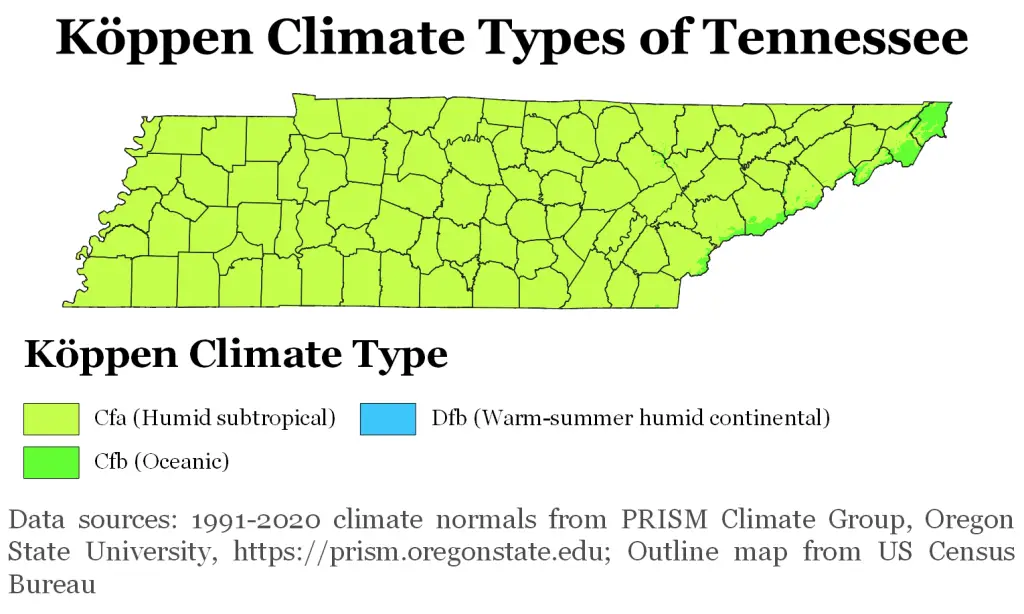Tennessee Plant Hardiness Zones
| USDA Hardiness Zone | Average Minimum Extreme Winter Temperature Range Fahrenheit (°F) Celsius (°C) | Average Last Frost Date Range In Spring (Beginning Of The Growing Season) | Average First Frost Date Range In Autumn (End Of The Growing Season) |
|---|---|---|---|
| 6a | -10°F to -5°F -23.3°C to 20.6°C | Late April to early May | Early to mid-October |
| 6b | -5°F to 0°F -20.6°C to 17.8°C | Late April to early May | Mid to late October |
| 7a | 0°F to 5°F -17°C to -15°C | Late April to early May | Mid to late October |
| 7b | 5°F to 10°F -15°C to -12.2°C | Early to mid-April | Late October to early November |
| 8a | 10°F to 15°F -12.2°C to -9.4°C | Late March to early April | Early to mid-November |
Tennessee Growing Conditions

General Climate
Tennessee’s hardiness zones range from 6a to 8a. The climate is humid subtropical. Some areas of higher elevation have an oceanic climate.
Overall, the state’s climate is moderate. This means that it has cool winters and warm summers. Tennessee does not experience cold harsh winters, with temperatures dipping no lower than -10°C (14°F).
The rest of the state experiences an average of -1°C (30°F) in the coldest month of January.
Summers are warm with upwards temperatures of 32°C (80°F) in the hottest month, July.
Precipitation occurs year round in Tennessee, the state sees an average of 51 inches annually.
Microclimates
USDA plant hardiness zones are an important starting point for your garden, but you’ll also need to consider microclimates.
Microclimates are areas where specific conditions create a climate different from the climate they’re situated in.
Buildings, fences, paved areas, or short hills and valleys can create these microclimates.
They can be as small as a space in your backyard or as large as a city.
In other words, learn about your local conditions from local experts to see if your garden falls into a microclimate.
Extreme Weather
Drought
During periods of prolonged drought, many homeowners struggle with their grass browning and dying. Water conservation is important during these times, which makes lawn watering low on the priority list.
Consider looking for lawn alternatives. Clover and native ground covers make excellent alternatives.
Compared to many varieties of grass, clover is:
- Drought-tolerant
- Spreads quickly
- Stays lush all year
- Requires less mowing and maintenance
- Provides a food source for local pollinators
- Looks pretty too!
Native ground covers are also suitable as a lawn alternative. These plants are accustomed to the climate of Tennessee and do well in a variety of weather. Some evergreen native ground covers include:
- Wild strawberry
- Golden ragwort
- Lyreleaf sage
- Wild stonecrop
- Common blue violet
The varieties’ requirements range from full sun to full shade. So, make sure to understand the amount of sun your area gets before making a selection!
Tornadoes
Following closely behind Tornado Alley, Dixie Alley is a southern extension of the tornado highway.
Tennessee is located in Dixie Alley and experiences tornadoes annually. Tornado season generally happens between February and April.
Because these events happen earlier in the season, starting seeds indoors is a good way to reduce the amount of plant damage during tornado season. Wait until the weather gets better to transplant your seedlings into the garden.
Growing Season
Tennessee has a long growing season! Typically, the state sees an average of 185 frost-free days. Zone 8a has the longest growing season in the state. Memphis and Chattanooga fall into this zone and have around 240 frost-free days.
Higher elevations have a shorter growing season with approximately 130 frost-free days per year. The climate is colder higher up, so these areas experience the coldest temperatures in the state.
Tennessee Gardening Tips

Creating A Woodland Garden
Dreaming of that beautiful shade garden but not sure what plants to use? Knowing the shade tolerance of plants is important when growing a garden.
Approximate 50% of Tennessee is forested. This creates a lot of potential for shade gardens to thrive.
Typically, shade gardens get 4 hours or less of sunlight a day. Because of this it’s important to do your research and determine which plants are best suited for shade.
My favorite version of a woodland garden is filled with native plants. There are some beautiful varieties that add whimsy, texture, and depth to create a romantic woodland vibe.
Some of my favorites include:
- Perennials:
- Trillium
- Foam flower
- Broad-leaved shooting star
- Ground cover:
- Bleeding heart
- Woodland strawberry
- Evergreen
- Deer tail fern
- Maidenhair fern
Hydrangeas are a shade tolerant shrub that add to a woodland garden vibe. For an impressive impact, try growing a vine variety up the north side of your home. Use a trellis to ensure your home is protected from the flowering vines.
Organic Solutions For Dealing With Cabbage Moths
Cabbage moths can be frustrating for any home grower. Tennessee has two species of cabbage moths.
These moths are considered pests because of their destructive eating of brassica crops such as cabbage, kale, and broccoli.
Here are a couple organic tips for dealing with these hungry cabbage moths:
Companion Planting
This is a natural and sustainable solution to deterring garden pests. Try planting herb varieties like:
- Sage
- Thyme
- Peppermint
- Dill
- Chamomile
- Rosemary
Plant flowers such as yarrow and buckwheat to draw in beneficial insects like ladybugs that eat cabbage moths.
Row cover
This lightweight material blocks out pests while still allowing sun and rain to penetrate through.
Make sure the row cover is pinned down around the planted row.
This material works best for low style growing crops like cabbage.
Use a day tent!
This fun little hack is useful for small-scale veggie gardening.
You can find a vestibule-style day tent at a homegoods store like Home Depot or Canadian Tire.
Cut the bottom out of the tent and peg all sides into the ground. Plant crops inside the tent for protection against garden pests.
Because it is a vestibule style, the crops still receive the light they need to thrive.
This method also increases humidity which creates a greenhouse effect, making the crops grow quicker!
Consult With Local Professionals
Consulting with local gardening professionals allows you to benefit from their experience with your area’s conditions, the plants that do well there, and overall best practices.
Tennessee Plant Suggestions

Trees
- Water tupelo (Nyssa aquatica)
- Tulip Tree (Liriodendron tulipifera)
- White Oak (Quercus alba)
Shrubs
- Western Spirea (Spiraea douglasii)
- Snowberry (Symphoricarpos albus)
- Mountain Azalea (Rhododendron canescens)
Flowers
- Early Meadow Rue (Thalictrum dioicum)
- Foam Flower (Tiarella cordifolia)
- Little Sweet Betsey (Trillium cuneatum)
Vegetables
- Cabbage (Brassica oleracea)
- Pepper (Capsicium species)
- Carrot (Daucus carota)
Herbs
- Silverleaf Mountain Mint (Pycnanthemum incanum)
- Scarlet Bee Balm (Monarda didyma)
- Sage (Salvia officinalis)
Spices
- Anise Root (Osmorhiza longistylis)
- Spicebush (Lindera benzoin)
- Chives (Allium schoenoprasum)
Fruits
- Muscadine grape (Vitis rotundifolia)
- Low bush Blueberry (Vaccinium angustifolium)
- Cranberry (Vaccinium macrocarpon)
Succulents
- Wild Stonecrop (Sedum ternatum)
- Eastern Prickly Pear (Opuntia humifusa)
- Hen and Chicks (Sempervivum tectorum)
Disclaimer
Any of the above can change and is not exhaustive.
Treat anything above like a good starter guide. Then use that as a foundation as you consult with local gardeners, professionals, forecasts, guides, and organizations.

